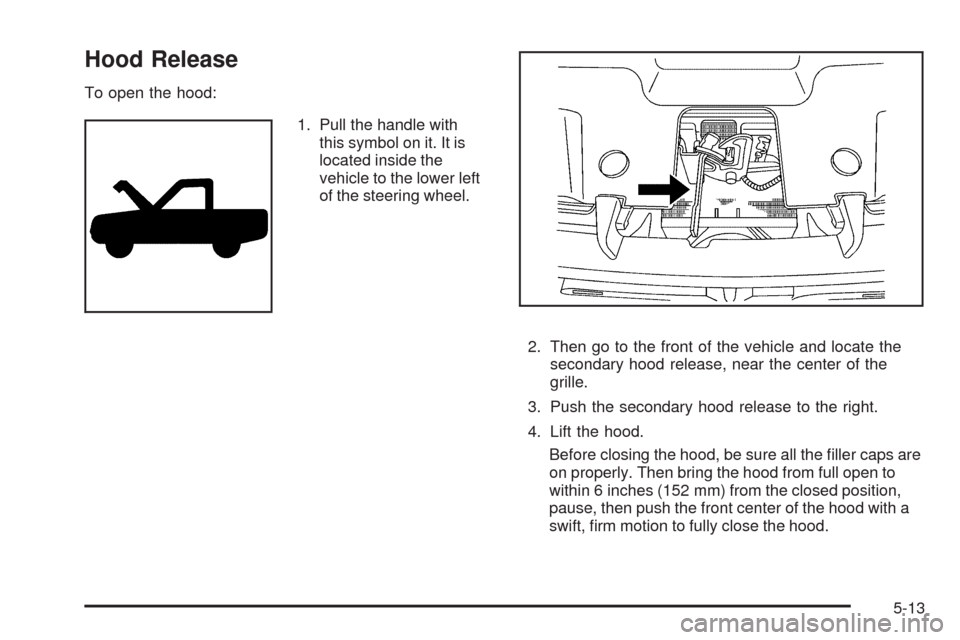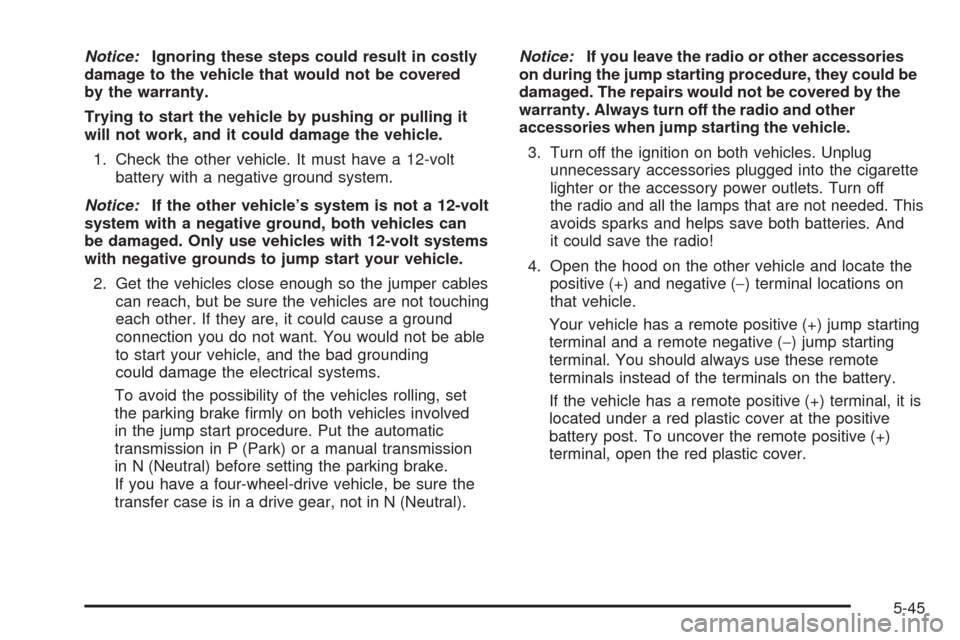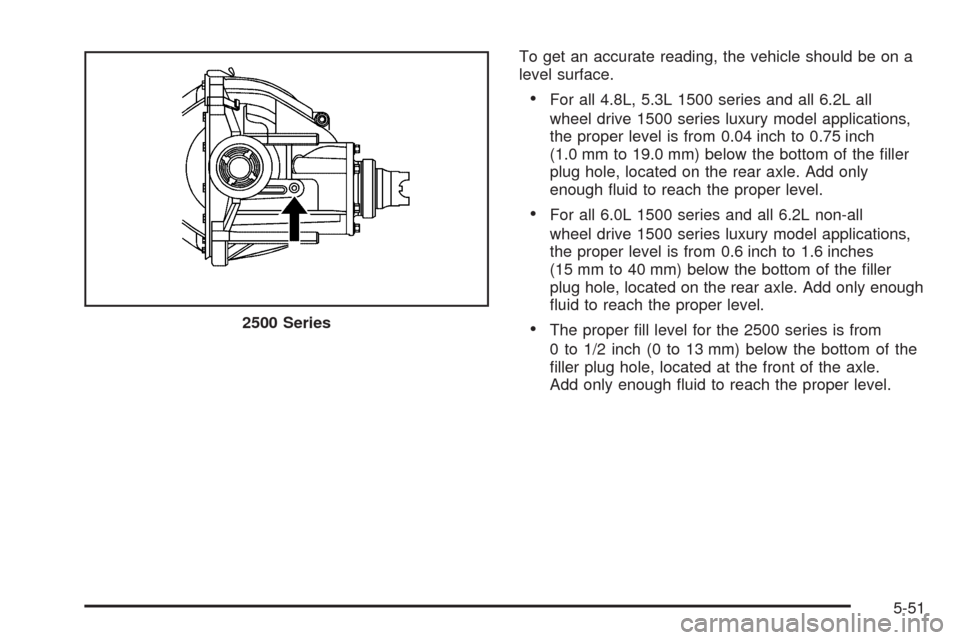2009 CHEVROLET TAHOE wheel
[x] Cancel search: wheelPage 396 of 574

Driving On Grades
Reduce speed and shift to a lower gearbefore
starting down a long or steep downgrade. If the
transmission is not shifted down, the brakes might have
to be used so much that they would get hot and no
longer work well.
Vehicles can tow in D (Drive). Shift the transmission to
a lower gear if the transmission shifts too often under
heavy loads and/or hilly conditions.
The tow/haul mode may be used if the transmission
shifts too often. SeeTow/Haul Mode Light on page 3-49.
When towing at high altitude on steep uphill grades,
consider the following: Engine coolant will boil at a lower
temperature than at normal altitudes. If the engine is
turned off immediately after towing at high altitude on
steep uphill grades, the vehicle may show signs similar to
engine overheating. To avoid this, let the engine run while
parked, preferably on level ground, with the automatic
transmission in P (Park) for a few minutes before turning
the engine off. If the overheat warning comes on, see
Engine Overheating on page 5-34.
Parking on Hills
{CAUTION:
Parking the vehicle on a hill with the trailer
attached can be dangerous. If something goes
wrong, the rig could start to move. People can be
injured, and both the vehicle and the trailer can be
damaged. When possible, always park the rig on a
�at surface.
If parking the rig on a hill:
1. Press the brake pedal, but do not shift into P (Park)
yet. Turn the wheels into the curb if facing downhill
or into traffic if facing uphill.
2. Have someone place chocks under the trailer
wheels.
3. When the wheel chocks are in place, release the
regular brakes until the chocks absorb the load.
4. Reapply the brake pedal. Then apply the parking
brake and shift into P (Park).
4-68
Page 397 of 574

5. If the vehicle is four-wheel-drive, be sure the
transfer case is in a drive gear and not in
N (Neutral).
6. Release the brake pedal.
{CAUTION:
It can be dangerous to get out of the vehicle if the
shift lever is not fully in P (Park) with the parking
brake �rmly set. The vehicle can roll.
If the engine has been left running, the vehicle can
move suddenly. You or others could be injured. To
be sure the vehicle will not move, even when on
fairly level ground, use the steps that follow.
Always put the shift lever fully in P (Park) with the
parking brake �rmly set.
Leaving After Parking on a Hill
1. Apply and hold the brake pedal while you:
Start the engine
Shift into a gear
Release the parking brake
2. Let up on the brake pedal.
3. Drive slowly until the trailer is clear of the chocks.
4. Stop and have someone pick up and store the
chocks.
Maintenance When Trailer Towing
The vehicle needs service more often when pulling a
trailer. See this manual’s Maintenance Schedule
or Index for more information. Things that are especially
important in trailer operation are automatic transmission
�uid, engine oil, axle lubricant, belts, cooling system
and brake system. It is a good idea to inspect
these before and during the trip.
Check periodically to see that all hitch nuts and bolts
are tight.
4-69
Page 401 of 574

Service............................................................5-3
Accessories and Modi�cations..........................5-3
California Proposition 65 Warning.....................5-4
California Perchlorate Materials Requirements.....5-4
Doing Your Own Service Work.........................5-4
Adding Equipment to the Outside of the
Vehicle......................................................5-5
Fuel................................................................5-5
Gasoline Octane............................................5-5
Gasoline Speci�cations....................................5-6
California Fuel...............................................5-6
Additives.......................................................5-6
Fuel E85 (85% Ethanol)..................................5-7
Fuels in Foreign Countries...............................5-8
Filling the Tank..............................................5-9
Filling a Portable Fuel Container.....................5-12
Checking Things Under the Hood....................5-12
Hood Release..............................................5-13
Engine Compartment Overview.......................5-14
Engine Oil...................................................5-15
Engine Oil Life System..................................5-18
Engine Air Cleaner/Filter................................5-20
Automatic Transmission Fluid
(6-Speed Transmission)..............................5-22Automatic Transmission Fluid
(4-Speed Transmission)..............................5-25
Cooling System............................................5-28
Engine Coolant.............................................5-29
Coolant Surge Tank Pressure Cap..................5-34
Engine Overheating.......................................5-34
Overheated Engine Protection Operating Mode . . .5-36
Engine Fan Noise.........................................5-37
Power Steering Fluid.....................................5-37
Windshield Washer Fluid................................5-39
Brakes........................................................5-40
Battery........................................................5-43
Jump Starting..............................................
.5-44
Rear Axle.......................................................5-50
Four-Wheel Drive............................................5-52
Front Axle......................................................5-53
Headlamp Aiming...........................................5-54
Bulb Replacement..........................................5-57
Halogen Bulbs..............................................5-57
Taillamps, Turn Signal, Stoplamps and
Back-up Lamps.........................................5-58
License Plate Lamp......................................5-59
Replacement Bulbs.......................................5-59
Windshield Wiper Blade Replacement..............5-60
Section 5 Service and Appearance Care
5-1
Page 402 of 574

Tires..............................................................5-62
Tire Sidewall Labeling...................................5-63
Tire Terminology and De�nitions.....................5-67
In�ation - Tire Pressure.................................5-70
Tire Pressure Monitor System.........................5-71
Tire Pressure Monitor Operation.....................5-73
Tire Inspection and Rotation...........................5-76
When It Is Time for New Tires.......................5-77
Buying New Tires.........................................5-78
Different Size Tires and Wheels......................5-80
Uniform Tire Quality Grading..........................5-80
Wheel Alignment and Tire Balance..................5-82
Wheel Replacement......................................5-82
Tire Chains..................................................5-84
If a Tire Goes Flat........................................5-85
Changing a Flat Tire.....................................5-86
Removing the Spare Tire and Tools................5-87
Removing the Flat Tire and Installing the
Spare Tire................................................5-92
Secondary Latch System...............................5-98
Storing a Flat or Spare Tire and Tools...........5-101
Spare Tire.................................................5-105
Appearance Care..........................................5-105
Interior Cleaning.........................................5-105
Fabric/Carpet..............................................5-107
Leather......................................................5-107Instrument Panel, Vinyl, and Other Plastic
Surfaces.................................................5-108
Care of Safety Belts....................................5-108
Weatherstrips.............................................5-108
Washing Your Vehicle..................................5-109
Cleaning Exterior Lamps/Lenses....................5-109
Finish Care................................................5-110
Windshield, Backglass, and Wiper Blades.......5-110
Aluminum or Chrome-Plated Wheels and Trim . . .5-111
Tires.........................................................5-112
Sheet Metal Damage...................................5-112
Finish Damage...........................................5-112
Underbody Maintenance...............................5-112
Chemical Paint Spotting...............................5-112
Vehicle Identi�cation.....................................5-113
Vehicle Identi�cation Number (VIN)................5-113
Service Parts Identi�cation Label...................5-113
Electrical System..........................................5-114
Add-On Electrical Equipment.........................5-114
Windshield Wiper Fuses...............................5-114
Power Windows and Other Power Options......5-114
Fuses and Circuit Breakers..........................5-114
Instrument Panel Fuse Block........................5-115
Center Instrument Panel Fuse Block..............5-117
Underhood Fuse Block................................5-118
Capacities and Speci�cations........................5-121
Section 5 Service and Appearance Care
5-2
Page 413 of 574

Hood Release
To open the hood:
1. Pull the handle with
this symbol on it. It is
located inside the
vehicle to the lower left
of the steering wheel.
2. Then go to the front of the vehicle and locate the
secondary hood release, near the center of the
grille.
3. Push the secondary hood release to the right.
4. Lift the hood.
Before closing the hood, be sure all the �ller caps are
on properly. Then bring the hood from full open to
within 6 inches (152 mm) from the closed position,
pause, then push the front center of the hood with a
swift, �rm motion to fully close the hood.
5-13
Page 442 of 574

Brake Wear
This vehicle has disc brakes. Disc brake pads have
built-in wear indicators that make a high-pitched warning
sound when the brake pads are worn and new pads
are needed. The sound can come and go or be heard all
the time the vehicle is moving, except when applying
the brake pedal �rmly.
{CAUTION:
The brake wear warning sound means that soon
the brakes will not work well. That could lead to an
accident. When the brake wear warning sound is
heard, have the vehicle serviced.
Notice:Continuing to drive with worn-out brake
pads could result in costly brake repair.Some driving conditions or climates can cause a brake
squeal when the brakes are �rst applied or lightly applied.
This does not mean something is wrong with the brakes.
Properly torqued wheel nuts are necessary to help
prevent brake pulsation. When tires are rotated, inspect
brake pads for wear and evenly tighten wheel nuts in
the proper sequence to torque speci�cations in
Capacities and Specifications on page 5-121.
Brake linings should always be replaced as complete
axle sets.Brake Pedal Travel
See your dealer/retailer if the brake pedal does not
return to normal height, or if there is a rapid increase in
pedal travel. This could be a sign that brake service
might be required.
5-42
Page 445 of 574

Notice:Ignoring these steps could result in costly
damage to the vehicle that would not be covered
by the warranty.
Trying to start the vehicle by pushing or pulling it
will not work, and it could damage the vehicle.
1. Check the other vehicle. It must have a 12-volt
battery with a negative ground system.
Notice:If the other vehicle’s system is not a 12-volt
system with a negative ground, both vehicles can
be damaged. Only use vehicles with 12-volt systems
with negative grounds to jump start your vehicle.
2. Get the vehicles close enough so the jumper cables
can reach, but be sure the vehicles are not touching
each other. If they are, it could cause a ground
connection you do not want. You would not be able
to start your vehicle, and the bad grounding
could damage the electrical systems.
To avoid the possibility of the vehicles rolling, set
the parking brake �rmly on both vehicles involved
in the jump start procedure. Put the automatic
transmission in P (Park) or a manual transmission
in N (Neutral) before setting the parking brake.
If you have a four-wheel-drive vehicle, be sure the
transfer case is in a drive gear, not in N (Neutral).Notice:If you leave the radio or other accessories
on during the jump starting procedure, they could be
damaged. The repairs would not be covered by the
warranty. Always turn off the radio and other
accessories when jump starting the vehicle.
3. Turn off the ignition on both vehicles. Unplug
unnecessary accessories plugged into the cigarette
lighter or the accessory power outlets. Turn off
the radio and all the lamps that are not needed. This
avoids sparks and helps save both batteries. And
it could save the radio!
4. Open the hood on the other vehicle and locate the
positive (+) and negative (−) terminal locations on
that vehicle.
Your vehicle has a remote positive (+) jump starting
terminal and a remote negative (−) jump starting
terminal. You should always use these remote
terminals instead of the terminals on the battery.
If the vehicle has a remote positive (+) terminal, it is
located under a red plastic cover at the positive
battery post. To uncover the remote positive (+)
terminal, open the red plastic cover.
5-45
Page 451 of 574

To get an accurate reading, the vehicle should be on a
level surface.
For all 4.8L, 5.3L 1500 series and all 6.2L all
wheel drive 1500 series luxury model applications,
the proper level is from 0.04 inch to 0.75 inch
(1.0 mm to 19.0 mm) below the bottom of the �ller
plug hole, located on the rear axle. Add only
enough �uid to reach the proper level.
For all 6.0L 1500 series and all 6.2L non-all
wheel drive 1500 series luxury model applications,
the proper level is from 0.6 inch to 1.6 inches
(15 mm to 40 mm) below the bottom of the �ller
plug hole, located on the rear axle. Add only enough
�uid to reach the proper level.
The proper �ll level for the 2500 series is from
0 to 1/2 inch (0 to 13 mm) below the bottom of the
�ller plug hole, located at the front of the axle.
Add only enough �uid to reach the proper level. 2500 Series
5-51